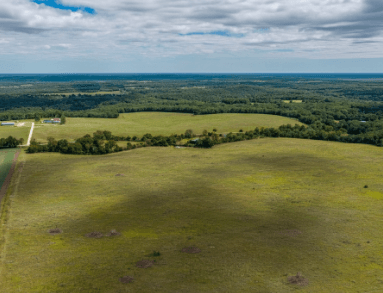How big is 10 acres? It’s a 435,600-square-foot space, equivalent to about 7.5 football fields, including end zones. Visualizing this expanse — roughly a square measuring 660 feet on each side — is the first step for any serious land investor seeking to understand its true potential and value. But beyond size, factors such as road access, zoning laws, utility availability, and topography determine how much of the land is truly usable for your goals. According to renowned real estate investors and cash land buyers, Steve Daria and Joleigh, understanding these practical details is the key to making a smart purchase. Answering “How big is 10 acres?” is not just about area but about opportunity, which can be difficult to assess on your own. To quickly size up a property’s potential, value, and investment viability, it helps to have an expert opinion. Book a free, no-pressure discussion with our team to clarify your next steps.
Key Points
- Understanding the Scale: Many investors often ask, “How big is 10 acres?” To put it into perspective, it’s about the same size as 7.5 football fields or roughly 435,600 square feet of open space. This amount of land provides plenty of flexibility for various uses, whether you’re planning residential development, agricultural ventures, or long-term investment projects.
- Visual Comparison: Still wondering “How big is 10 acres?” Picture a large city block multiplied several times or a small community park with wide-open areas. You could fit around 150 average-sized homes on this land, giving investors a realistic visualization of its size and potential.
- Agricultural Opportunities: Ten acres is an ideal amount of land for small-scale farming, orchards, or livestock operations. It provides enough room to operate efficiently while remaining manageable for individual or family-run agricultural businesses.
- Development Flexibility: This land size offers multiple options—building private estates, subdividing for housing, or establishing eco-lodges. Its versatility makes it attractive to both developers and long-term investors.
- Long-Term Value: A 10-acre property tends to appreciate over time, especially in expanding regions. With thoughtful planning, it can yield consistent returns while maintaining strong resale and investment value.
What is an Acre?
Before answering the question, “How big is 10 acres?” we must first understand what an acre is.
An acre is a unit of area commonly used in the United States to measure large plots of land.
One acre equals 43,560 square feet.
This measurement originates from agricultural practices, representing the amount of land one ox could plow in a day.

How Big is 10 Acres?
How big is 10 acres, exactly? When we multiply the square footage of one acre by 10, we get 435,600 square feet.
This vast expanse can accommodate various activities and developments, making it a versatile unit of measurement for land investors and developers.
Converting Acres to Other Units
For a clearer visual perspective, converting acres to other units can be helpful:
- 10 acres = 4.05 hectares
- 10 acres = 0.015 square miles
- 10 acres = 1,742,400 square inches
Get Started: Get Your Cash Offer Below…
We are direct land buyers. There are no commissions or fees and no obligation whatsoever. Start below by sharing where your property is and where we can send your offer…
Visualizing 10 Acres
The query, “How big is 10 acres?” can be challenging, but comparing it to familiar spaces can help.
Here are some comparisons to give you a better idea:
Football Fields
A standard American football field with end zones is about 1.32 acres.
Therefore, 10 acres would equal roughly 7.6 football fields.
To visualize this, imagine standing on one end of a football field and looking down its length, then extending that view to nearly eight fields.
This substantial area emphasizes how expansive 10 acres can be, making it a helpful comparison for understanding large land sizes.
City Blocks
One city block is approximately 2.5 acres in many urban areas.
Thus, 10 acres would cover around four city blocks.
This means you could fit the space of four city blocks within a 10-acre plot, giving you a sense of this area’s significant footprint in an urban context.
It’s a helpful comparison for visualizing large plots of land in terms familiar to city dwellers.
Homes
The average single-family home in the U.S. sits on about 0.2 acres.
Consequently, 10 acres could accommodate around 50 homes.
This comparison illustrates how 10 acres can translate into many residential lots, clearly showing its vastness.
It underscores the potential for development within such an expansive area, whether for housing, farming, or other purposes.
Practical Uses for 10 Acres
How big is 10 acres? Investing in 10 acres offers numerous possibilities, from agricultural ventures to residential developments.
Here are some practical uses for such a large plot of land:
Agricultural Ventures
For those interested in farming, 10 acres provide ample space for various agricultural activities.
You can grow multiple crops, such as vegetables, grains, or fruits, or raise livestock like cattle, goats, or chickens.
Additionally, with 10 acres, you could start a small orchard or vineyard, creating the potential for a diversified and sustainable farming operation that can meet local demand and generate a steady income.
Residential Developments
Developers can create residential communities on 10 acres, leveraging the space to build multiple single-family homes, townhouses, or even apartment complexes.
With thoughtful urban planning, such a development can include amenities like parks, playgrounds, and communal spaces, enhancing the appeal and livability of the neighborhood.
Properly executed, a 10-acre residential development can yield significant returns, attracting homebuyers and investors.
Commercial Projects
Commercial projects such as shopping centers, office parks, or industrial facilities can thrive on 10 acres due to the ample space available for diverse needs.
This area can accommodate extensive parking facilities, green spaces, and sizable building structures, creating an attractive and functional business environment.
With the proper planning and investment, a 10-acre commercial project can become a hub of economic activity, drawing customers and companies to the area and driving growth and profitability.
Maximizing the Value of 10 Acres
To get the most out of your 10-acre investment, consider these strategies:
Zoning and Land Use
Before purchasing or developing 10 acres, check local land zoning and regulations and land use regulations.
These rules dictate what activities are permitted on the land, affecting your investment strategy.

Infrastructure and Utilities
Ensure your 10-acre plot can access essential infrastructure and utilities like roads, water, electricity, and sewage.
The availability of these services can impact the land’s value and usability.
Sustainable Practices
Implementing sustainable practices can enhance the long-term value of your 10-acre property.
To attract environmentally conscious buyers or tenants, consider eco-friendly building materials, renewable energy sources, and water conservation methods.
Tips for Prospective Buyers and Investors
If you’re considering investing in 10 acres, keep these tips in mind:
Conduct Thorough Research
Research the area where the 10-acre plot is located to gain insight into its potential and value.
Look into local market trends, recent property sales, and future development plans, as these things can significantly impact the property’s appreciation and suitability for your intended use.
Understanding the broader context, such as zoning laws and community plans, will help you make a well-informed investment decision.
Assess Accessibility
Evaluate the 10-acre plot’s accessibility by considering its proximity to major roads, highways, and public transportation.
Easy access to important amenities like schools, hospitals, and shopping centers can significantly influence the property’s desirability and value, making it more attractive to potential buyers or tenants.
Plan for Future Growth
When investing in 10 acres, consider the potential for future growth.
Ask yourself, “How big is 10 acres?” as you evaluate how the land can be developed or repurposed as market conditions change.
Flexibility can lead to higher returns on your investment.
**NOTICE: Please note that the content presented in this post is intended solely for informational and educational purposes. It should not be construed as legal or financial advice or relied upon as a replacement for consultation with a qualified attorney or CPA. For specific guidance on legal or financial matters, readers are encouraged to seek professional assistance from an attorney, CPA, or other appropriate professional regarding the subject matter.
